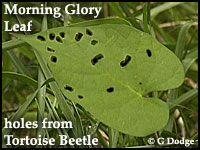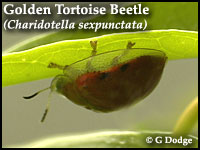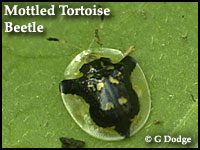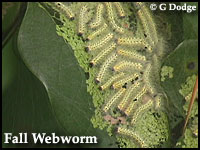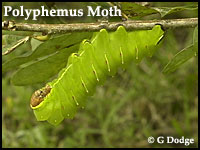While watching a small Northern Water Snake stalk frogs from the Wetlands Overlook, I happened to see something wiggling amongst the dense plants in the water. A quick look through my binoculars revealed two large Predaceous Diving Beetle larvae locked in mortal combat, one had a death grip on the other. These larvae were quite large. Depending upon the species, Predacious Diving Beetle larvae, or Water Tigers as they’re sometimes called, can get to 70 mm (2.75”). They have large pincer-like jaws. They’re impressive.
If you come across Morning Glory on your stroll around the Explore the Wild/Catch the Wind Loop and you happen to notice small holes in the leaves of the plant, take a closer look: a Golden Tortoise Beetle (Charidotella sexpunctata) may be nearby, possibly on the underside of one of the leaves. They eat the leaves of plants in the Morning Glory family. These beetles have the ability to change colors, and they can do so rather quickly. I picked a beetle off a leaf at the Wetlands Overlook near the Lemur House. As I was showing the beetle to a few Museum guests, the beetle changed from brilliant gold to a much subdued reddish color.
There are six spots on the elytra (the forewings, or back of the beetle) which is where this beetle gets the species name sexpunctata. Unfortunately, the photo below doesn’t show the golden color. However, it does show another interesting feature of this tiny (1/4”) beetle. The elytra is transparent around the edges! Neat little beetle.
I discovered another tortoise beetle, a Mottled Tortoise Beetle (Deloyala guttata), on the Morning Glory which covers a good portion of the fence in front of the Red Wolf Overlook. Look for the leaves with the holes in them!
Fall Webworms are at work in Explore the Wild. I noticed the first “webs” of the season on a Redbud Tree off the boardwalk leading down into the Wetlands. Webworms differ from Tent Caterpillars in that the webworm’s silken webs are constructed at the end of the tree’s branches, covering the leaves. The caterpillars feed on the leaves within the protection of the webs. Tent Caterpillars make a silk “tent” in the crotch of the tree, where several branches meet, venturing outside the tent to feed on the tree’s leaves. Tent Caterpillars are active in the spring, not late summer and fall like the webworms.
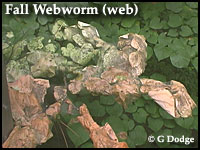
While investigating frass (caterpillar poop) on the ground beneath a small oak tree and then looking up to see where it had come from, I happened upon a Polyphemus Moth caterpillar. This is a beautiful caterpillar. It’s not the largest caterpillar out there but at about 3 inches it’s one of the largest in our area. Polyphemus was the name of the cyclops blinded by Odysseus in Greek mythology. The adult moth of this caterpillar has one large eye-spot on each hindwing.
Among the butterflies seen over this period were Monarch, Questionmark, Eastern-tailed Blue, Pearl Crescent, Spicebush Swallowtail, Cloudless Sulphur, and Silver-spotted Skipper as well as several other grass skippers. Cloudless Sulphur and Monarch were notable in that they’d been absent for the past few months.
Monarchs are well known for moving north in the spring and early summer and south during late summer and fall. And, I’ve counted Cloudless Sulphurs moving northeast by the thousands on the coastal plain during late August. Although this is the piedmont and not the coastal plain, I would expect to see at least some Cloudless Sulphurs here in the second half of August. Even so, the individuals that I’d seen in the early part of this period, of both of these species, were not moving in any particular compass direction; they seemed to be concentrating on finding nectar sources. The last week of this period, Monarchs and Cloudless Sulphurs were beating it towards the southwest, without hesitation.
There was a Crayfish in the water at the Wetlands Overlook, the first I’d seen. I’d been told that they were present but hadn’t seen one myself until August 18 while I was peering over the boardwalk railing looking for frogs.
I saw the first large Argiope (ar-GUY-o-pee) Spider of the season on a Red Cedar in front of the Sailboat Pond on August 21. They’ve been around all summer, but they’re not as obvious as they are in late summer/fall when they’ve grown to a size that’s, well, noticeable. The web has a zig-zag pattern down the middle section making it fairly easy to spot. Even so, when the spiders are small, their webs are also small and usually down low in the grass where they’re not so apparent. The spider in the Red Cedar was apparently not satisfied with the productivity of its web in the tree because the next day the web was placed down in the tall grass behind the tree. This web looked to be in a better spot to me too, more airborne traffic. There was a grasshopper caught in the web on the last day of the month.
Other orb weavers have been noted elsewhere around the Explore the Wild/Catch the Wind Loop. We’ll be seeing more as the season moves on.
I’ve seen 2 millipedes in the past two weeks. Both were seen just past the Lemur House on the way to Catch the Wind. One was walking across the paved path. The other had been doing the same but apparently hadn’t quite made it all the way across before getting stepped on. As far as I can determine they both were in the Spirobolidae family of millipedes, Narceus americanus. They are the long, round-bodied (in cross section) millipedes of our area, not the flat-bodied, black-and-yellow millipedes which seem to be much more common. Interesting to watch, millipedes, all those legs moving that long body down the path, hardly missing a step.
